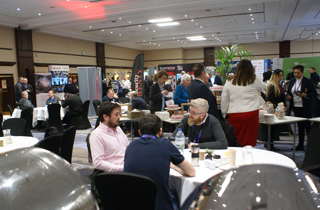Here is part three of four of ‘Roy’s rules’; Professional Security MD Roy Cooper’s talk before each Security TWENTY event about how to make the most of exhibiting at the ST regional series of shows.
He went on to examples of good, and bad, practice. Why sit at your laptop in the name of keeping up with mail? That’s not why you or someone at your company have paid to exhibit at ST; you are here to get inquiries. On that point, avoid huddles with your fellow staff; because visitors will not want to break up the ‘party’. No private chats while visitors are around. Roy recalled one ST day when a sales manager held an impromptu sales meeting, and complained later that there weren’t any visitors, although in truth there were hundreds.
Consider standing up – yes, it can be hard to stay on your feet all day – to people who walk up to your table. When manning a stand, be mindful of your body language. Make sure you smile, and look out, to make eye contact with individuals; don’t be on your phone, and don’t look fed up. Having made contact, provide reasons for people to talk to you, beyond having that appealing-looking, and colourful stand. Encourage trials of your app or software. Roy used here the idea of ‘puppy dog sales’ – literally if you are selling a puppy, and someone has it in their hands, and they don’t want to hand it back to the salesman. So demonstrate your equipment, such as an access control card. Consider providing fun, whether a prize draw or a game. The golden rule is, make sure that your ‘participation props’ support your message about how you and your company can help that visitor.
Do not eat and drink when visitors are around; Roy recalled once being asked by a visitor let them know when an exhibitor had finished eating, so that the visitors could speak to the exhibitor. On the web, you can see example of general bad practice at a show, and ST organiser Liz Lloyd ran one or two. Roy went on to what to actually say in conversation to the stand visitor. As in a shop, avoid closed questions that allow the visitor to say a blank yes or no. Instead, ask open questions such as: why are you here, or even ask what the weather is outside. Just don’t be rude or pushy.
Do not make assumptions about people. Such as – and it got an agreement with a similar story from one person around the table at : that scruffy guy or girl? It could be a manager or buyer, while the woman in a smart suit may be a competitor of yours.
If you are asking those questions of people, listen carefully to the answers. If a visitors asks, do you have that product in blue, does that mean; if you do have it in blue, you can make a sale?! Roy pointed out that difference between a product feature, and a product’s benefit. He gave a tea mug as an example, that has a handle on the mug as a feature. The benefit is that you can hold the handle so that the hot tea does not hurt your hand. Rather than use jargon, try to use the phrase ‘which means that’, to explain what a product can do, and where.
Pictured; a new feature of the ST shows, at ST20 Birmingham at the Hilton Metropole at the NEC last month; a central seating area.
Part four of four; summing up with a few dos and don’ts.










